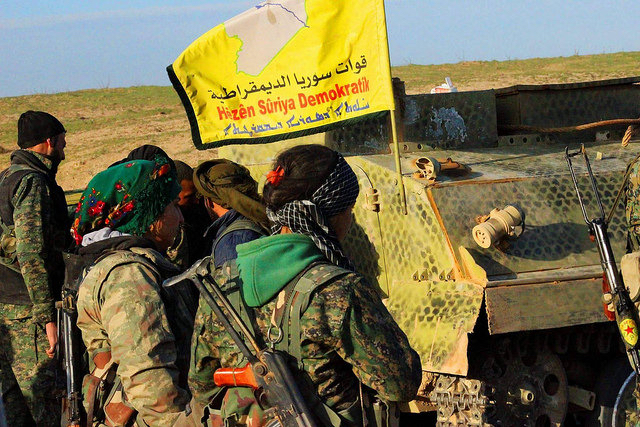Ahrar al-Sham’s decision to replace its top command this week offers a glimpse at how the outgunned rebel group is adjusting to the ascendancy of al-Qaida-linked factions in Syria, and the changing nature of the insurgency against president Bashar al-Assad.
Beirut – An embattled Syrian militant group that was once considered to be one of the strongest factions of the Syrian opposition has shuffled its senior leadership this week. Its aim is to preserve internal unity and reduce tensions with its al-Qaida rival.
Ahrar al-Sham’s decision to elect a new head on Monday shows how Syria’s outgunned opposition is adjusting to the increasingly dominant al-Qaida-linked Hay’at Tahrir al-Sham (HTS) alliance. As Syrian rebel groups opposing President Bashar al-Assad falter across Syria, Ahrar al-Sham sought out a new leader who they hope will keep them from becoming obsolete.
The election of Hassan Soufan “comes at an intensely challenging time for the group, which is arguably at the weakest point in its history,” Charles Lister, a senior fellow at the Middle East Institute and author of the book The Syrian Jihad, told Syria Deeply.
Ahrar al-Sham is currently on the ropes in the war-torn country: it has been forced out of a lucrative border crossing into Turkey and has suffered a string of territorial defeats in rebel-held Idlib province after coming under attack by HTS in recent weeks.
Earlier this year, tensions escalated between Ahrar al Sham and HTS’s predecessor- Jabhat Fatah al-Sham (JFS), creating a divide within the rebel group. Thousands of hardline Ahrar al Sham fighters, who are sympathetic to al-Qaida, defected from the movement to join JFS in forming the HTSalliance. Long-standing divisions over the group’s future, however, continue to weigh heavily.
With the election of Soufan, Ahrar al-Sham is hoping to dampen the rivalry with HTS and maintain internal unity on the group’s future, two sources from the group told Syria Deeply.
“The [crisis] is the reason behind this change in leadership,” an Ahrar al-Sham politburo member told Syria Deeply on the condition of anonymity.
Omar Khattab, an Ahrar al-Sham military spokesman, corroborated the statement. “There is no doubt that internal conflicts and incidents of injustice and aggression [by HTS] necessitated the pumping of new blood into the group’s leadership,” he said.
Ahrar al-Sham’s New Leader
Hassan Soufan is an ambiguous figure. The 38-year-old Syrian from the port city of Latakia spent most of the six-year-long war locked up in the government’s notorious Sednaya prison, where he was detained for roughly a decade on unknown charges. The reasons for his arrest remain largely unclear and sources inside Ahrar al-Sham refused to disclose this information.
According to the Ahrar al-Sham politburo member, Soufan was arrested after he was extradited to Damascus from Saudi Arabia, as part of a prisoner swap between the two countries in 2005. Activist-run media outlets like Enab Baladi and Aleppo 24 corroborate this information. The exact terms of the agreement remain unknown, but Syrian state media reported on July 27, 2005, that Damascus had extradited 12 Saudi extremists to their country of origin.
While in jail, Soufan became a prominent figure among inmates, including Islamists who would later go on to form the Ahrar al-Sham group in 2011.
In July 2008, Islamist prisoners, including al-Qaida fighters, rioted in the jail after a contingent of military police officers conducted an aggressive search on their block. According to Human Rights Watch, the military police opened fire, killing at least 25 inmates. Following the shooting, detainees overpowered the security guards and took several hostages, including the prison director.
Soufan was chosen to be part of a four-member inmate delegation tasked with negotiating with the Syrian government to solve the ordeal. He also led tense negotiations with hardline al-Qaida detainees who were pushing back against talks with the government. Eventually, the inmate delegation, which included an al-Qaida representative and a detainee who would go on to become one of Ahrar al-Sham’s leading clerics, carried out talks with Syrian government for four days to find a solution to the hostage crisis.
In December 2016, Ahrar al-Sham officials lobbied the Syrian government for Soufan’s release in exchange for more than a dozen pro-government fighters held captive by the group. Upon his release, he was immediately appointed to one of the group’s most senior posts, the head of Ahrar al-Sham’s Shura Council.
“When he was released from prison, he already had been known to be ideologically close to Ahrar al Sham. This was discovered by the founders who were with him in Sednaya prison,” the politburo Ahrar al-Sham member told Syria Deeply. “This is why as soon as he was released from jail, he was placed with the leadership of the group.”
The Task Ahead
Soufan’s experience negotiating with al-Qaida-linked militant groups during the Sednaya riots impacted his appointment as head of the group, according to the Ahrar al-Sham politburo member.
“He is the best person to oversee this phase in terms of the strength of his personality, his good management skills and his history of dealing with extremist groups in the context of crisis,” he said. “And we are in a crisis.”
When asked what was expected of Soufan in terms of relations with HTS, the politburo member said that there would be no efforts towards reconciliation, but that attempts would be made to establish a “formula” to “reduce tensions” between the groups.
“Because of his experience negotiating with extremist groups in Sednaya, we think he might be successful in doing this,” he said.
Lister, an expert on Syria’s anti-government insurgency, echoed a similar assessment.
“Soufan has built a reputation as a credible and consistent leader and someone with a history of leading complex and drawn-out negotiations, both strengths that apparently saw him win the internal Ahrar shura election,” he said.
But reducing tensions is not his main imperative.
According to Lister, the internal unity of the group figures prominently in the reasons for Soufan’s elections. This was corroborated by Ahrar al-Sham’s military spokesman, who said that consolidating the group’s internal ranks is among the new leader’s “top priorities.”
Internal friction within Ahrar al-Sham grew exponentially over the past 12 months, leading to the emergence of two rival camps. On the one side there is a hardline faction that advocates for closer ties to HTS. On the other hand stands a bloc of pragmatic members who tend to be uneasy about an alliance with extremist groups. They favor working instead with more nationalist rebels like the Free Syrian Army and foreign states like Turkey.
“Being such a large group, Ahrar al-Sham has always struggled to define and to maintain a single ideological and political identity, but I think that’s really been challenged in the last 12 months. The increasing strains with [al-Qaida-linked militants] that reached their peak this year threw portions of the group into disarray,” Lister said.
“I’m reliably told … that Soufan intends to address internal differences of opinion regarding Ahrar’s vision for the future.”
This article originally appeared on Syria Deeply, and you can find the original here. For important news about the war in Syria, you can sign up to the Syria Deeply email list. Screen shot courtesy of Malcomxtreme. Published under a Creative Commons license.





